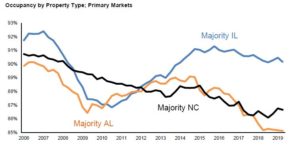Assisted Living Occupancy Continues to Decline in 2019
Current Senior Housing Trends Using NIC Data
Senior living occupancy has dropped again per the latest reporting from the NIC from 2Q19. The latest census report shows senior housing down YOY and at the lowest level since 2011. According to the most recent NIC Map® this occupancy decline is especially true in the Assisted Living showing 85.1% occupancy across all primary markets.

Source: NIC Map®
Unfortunately, this trend does not appear to be getting any better for the foreseeable future. Annual inventory growth for primary markets continue to outpace the penetration rates, and the average resident entry age continues to grow. The baby boomer myth of 2026 being the year for senior living, is continuing to fall short of the realities.
According to the NIC Investment Guide, Fifth Edition, the average age of an Independent Living (IL) resident is 83 and 84 in Assisted Living (AL). The oldest baby boomer born in 1950 will hit 83 in the year 2033.
Senior Housing Solutions for Asset Profitability
The idea that an operator can be an excellent operator and manager is to miss the intricacies of senior living. Senior living is more than just real estate to be managed as MFHs or MOBs. To read more about the differences in senior housing management as compared to operations, please read our article: Management is Not Operations.
The success of an asset has more to do with the people in the community and their priorities than the local demographic and climate. Typically, an under-performing property is met with a solution that includes some level of restructuring. However, these changes in management come without a change in local strategy. ETROS offers a new solution – asset management specializing in turnarounds, value-adds, and under-performing senior housing and nursing assets.
1. RIDEAs (REIT Investment Diversification and Empowerment Act)
Over the years, it's become commonplace to watch investors and operators move away from triple-net agreements and restructure into a RIDEA. Senior living operators struggling for cash flow and debt relief welcomed the agreements while investors welcomed the chance to take part in the growing upside.
A cash injection does not improve a struggling strategy. An investor seeking to manage an operator through additional communication with the operating Executive Leadership team will garner the same, or similar, results received prior to the RIDEA.
2. Operator Change
When an investor enters into a multi-year contract with different operator, it is a thoughtful decision that is not taken lightly. Business relationships can be damaged in the fallout of contract negotiations when an operator is removed from a project.
In most changes to operators, it requires an asset to undergo a complete marketing analysis and change in brand. This branding change in the market dissolves the previous brand recognition effecting both the internal and external identity. A community's resident population, resident families, community staff, and prospective clients all must rebuild trust in a new brand.
The basics of new systems and new protocols for a community are always a financial and time consideration. More importantly, consider how this affects the local team who achieve the new results. New operations come with new reporting structures, new reports, and a new culture to understand and adapt. These financial and time considerations must have a defined ROI on a high-water mark.
3. ETROS Management Firm: Results. Not Recommendations.
ETROS plays a critical role of asset manager for senior-housing and nursing assets. ETROS sets and executes the strategy for top and bottom-line performance for the assets. The operator branding, policies, and procedures remain in place preserving operational partnerships. Under a typical ETROS agreement, the community is restructured in that the asset becomes fully managed by ETROS with daily back end operations continuing to be provided by the operating company. This is how ETROS gets results. Strategy implementation, accountability and culture is how results are made and where recommendations fall short.
No-fault contracts with a 45-day out are standard. This set up provides that it's as easy to start with ETROS as it is to get out.
Source: https://etros.com/2019/07/future-solutions-to-senior-housing-declines/

0 Response to "Assisted Living Occupancy Continues to Decline in 2019"
Post a Comment